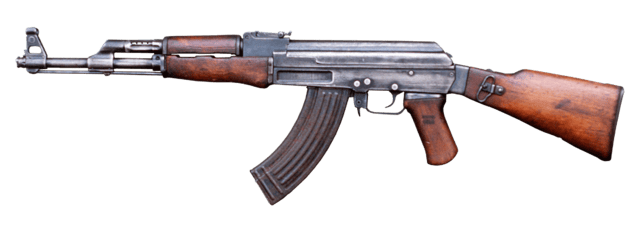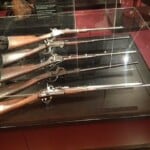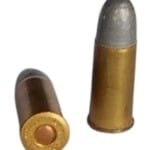
Russian Small-Arms Firepower: AK-47
One of the most recognized and widely used firearms in the world is the AK-47. Developed by Mikhail Kalashnikov, a former Soviet Union tank mechanic, in 1947, the AK-47 has since become a symbol of resistance, rebellion, and armed forces around the globe due to its simplicity, reliability, and cost-effectiveness.
The AK-47's Development
Mikhail Kalashnikov started the development of this iconic weapon when he was in a hospital recovering from injuries during World War II. Disturbed by the relative inferiority of Soviet small arms compared to their German counterparts, he began sketching ideas for a new rifle. His design eventually won a competition to replace the Soviet Red Army's standard issue rifle, the Mosin-Nagant bolt-action rifle and the semi-automatic Tokarev SVT-40.
The AK-47 (Avtomat Kalashnikova model 1947) was officially accepted by the Soviet Armed Forces in 1949. It was a selective-fire, gas-operated 7.62x39mm assault rifle, which incorporated design features from other contemporary semi-automatic and automatic rifles, like the American M1 Garand and the German StG 44. The key to the rifle's success was its simplicity. It was designed with fewer parts than other contemporary firearms, which allowed it to be produced quickly, cheaply, and with a lower requirement for skilled labor.
Manufacture and Companies Involved
The primary company that manufactured the AK-47 was Izhmash, now known as the Kalashnikov Concern, located in Izhevsk, Russia. However, due to its widespread adoption, the rifle and its variants have been produced by dozens of countries, including China (Norinco Type 56), Hungary (FEG AMP-69), and Romania (AIM).
In total, estimates suggest that as many as 75 million AK-47s have been produced by various manufacturers worldwide. This production spans from the late 1940s to the present day, although the exact number is difficult to determine due to the widespread unlicensed production.
It should be noted that a very popular variant, the AKM, was introduced in 1959. This model had several design adjustments, such as a stamped metal receiver instead of a milled one to reduce cost and weight. Many AKs produced today are in fact AKMs or derivatives of this model.
Usage by Agencies and Militaries
The AK-47 quickly became the standard service rifle of the USSR upon its adoption in 1949. It was also widely exported to other communist and allied countries during the Cold War. Numerous national liberation movements, as well as insurgent and terrorist organizations worldwide, have also used it due to its reliability, ease of use, and availability.
Regarding U.S usage, it's interesting to note that while the AK-47 has been used extensively by U.S adversaries, the American military itself has rarely used the rifle. The U.S has typically equipped its troops with domestic designs, such as the M16 and M4 carbine. However, Special Forces units have occasionally used the AK-47 and its variants when operating in areas where these weapons are common to blend in and for logistical compatibility. The CIA also provided millions of Chinese-made AK-47s to Afghan Mujahideen fighters during the Soviet-Afghan war.
The AK-47 Cartridge: 7.62x39mm
The AK-47 uses the 7.62x39mm cartridge. This round was designed during World War II by the Soviet Union for use in the SKS Carbine and later the AK-47. The
7.62x39mm round is known for its reliability in various conditions, ease of manufacturing, and adequate penetration and stopping power. The round is shorter and wider than the American 5.56x45mm NATO round, giving it better performance in close-quarters engagements and in penetrating cover, but less accuracy and velocity at longer ranges.
The AK-47's Predecessors and Successors
The AK-47's direct predecessor was the semi-automatic Tokarev SVT-40 rifle, widely used by the Soviet Union during WWII. However, the rifle also took inspiration from other rifles. For instance, the gas-operated firing mechanism was borrowed from the American M1 Garand, while the curved magazine was similar to that of the German StG 44.
The AK-47 has seen many upgrades and successors, with the AKM and AK-74 being the most notable. The AKM, as previously mentioned, introduced a lighter and cheaper to manufacture stamped steel receiver. The AK-74, developed in the early 1970s, switched to a smaller, faster 5.45x39mm cartridge, providing better range and accuracy.
Other Rifles in Use
During the period of the AK-47's development and use, several other significant rifles were in service. The US military primarily used the M14 rifle until it was replaced by the M16 in the mid-1960s. The M16, using a smaller, high-velocity 5.56x45mm round, offered better control and accuracy, especially at longer ranges. However, it initially suffered from reliability issues in the harsh conditions of the Vietnam War.
On the other side of the Iron Curtain, East German forces used the locally produced MPi-K, a variant of the AK-47. North Vietnamese forces were known to use a mixture of SKS carbines, AK-47s, and even captured American weapons.
The UK’s armed forces used the L1A1 Self-Loading Rifle, a semi-automatic version of the Belgian FN FAL, until the 1980s when it was replaced by the L85A1, a bullpup design.
Conclusion
The AK-47's profound impact on the world cannot be overstated. It democratized the concept of firepower, being easy to use, manufacture, and maintain. Despite newer designs and variants, the AK-47 continues to be a prominent feature in global armed conflicts, a testament to Kalashnikov's design that prioritized utility, simplicity, and reliability above all. Its place in global history is firmly established, continuing to be a significant factor in conflicts and symbolizing rebellion and resistance worldwide.
Discussion forums can be found here:
- The AK Forum
- www.ar15.com (I know, right...but they do have an AK forum)
- Gunsnet.net
If you know of any forums or sites that should be referenced on this listing, please let us know here.




